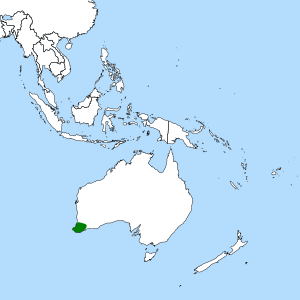Badisis facts for kids
Quick facts for kids Badisis ambulans |
|
|---|---|
| Scientific classification | |
| Kingdom: | |
| Phylum: | |
| Class: | |
| Order: | |
| Family: |
Micropezidae
|
| Subfamily: |
Micropezinae
|
| Tribe: |
Metopochetini
|
| Genus: |
Badisis
McAlpine, 1990
|
| Species: |
B. ambulans
|
| Binomial name | |
| Badisis ambulans McAlpine, 1990
|
|
 |
|
| Global range of Albany Pitcher Plant: maximum range of Badisis ambulans | |
Badisis is a special type of fly known as a stilt-legged fly. There is only one known species in this group, called Badisis ambulans. This fly is very unique because it does not have wings or special balancing organs called halteres. It also looks a lot like an ant!
You can only find Badisis ambulans in a specific part of Western Australia, in a region known as Southwest Australia. This fly depends on a rare plant called the Albany Pitcher Plant (Cephalotus follicularis) to grow. Because of this, Badisis ambulans is also a rare species.
Even though it has many special features, its body shape suggests it is closely related to another group of flies called Metopochetus. Both belong to the same tribe, Metopochetini. An ancient fossil fly found in Baltic amber, called "Electrobata" tertiaria, also shares some similarities.
Contents
What Does Badisis ambulans Look Like?
B. ambulans is different from most other stilt-legged flies because it does not have wings or halteres. Its body is more solid, and its abdomen is narrow at the base, like an ant's. Its middle and back legs are not as long as other stilt-legged flies, and its front legs are not as short. This makes it easy to mistake for an ant.
Male and female flies look almost the same. You can only tell them apart by looking very closely at the end of their bodies with a microscope. The young flies, called larvae, are specially adapted to live inside the pitchers of the Albany Pitcher Plant.
Head Features
The compound eyes of Badisis are large, similar to those of Metopochetus. This is unusual for wingless flies, as many of them do not have eyes at all. The third part of its antenna is long and oval-shaped. It usually has three tiny hairs, called bristles, on each side of its "forehead."
Body (Thorax) Features
The scutellum, a part of the fly's back, is small but easy to see. Like many other flies in its group, it does not have a groove connecting the lines across the middle of its body. The back part of its body, called the metathorax, has a saddle-shaped plate on top.
Abdomen Features
The narrow part of the abdomen, called the petiole, is made up of the first two segments. The first segment has a small bump on its upper side. The male's abdomen end is very special. It has a unique shape with two small parts, each with a few strong bristles. This part looks very similar to the fossil fly "Electrobata" tertiaria.
Leg Features
The front legs have a tooth-like bump on their lower front end. This feature is only found in Badisis and Metopochetus flies. The middle and back legs have fine hairs and many scattered, thicker bristles.
Where Does Badisis ambulans Live and How Is It Doing?
Males of B. ambulans are seen much more often than females. Females were only described eight years after the males! These flies live in sclerophyll forest areas. Males are sometimes found on the flowers of a Myrtaceae shrub called Astartea fascicularis. If they feel in danger, they will try to escape by hopping or dropping to the ground to hide.
The young flies, or larvae, have only been found inside the pitchers of the Albany Pitcher Plant (Cephalotus follicularis). This carnivorous plant only grows in a small area of southwestern Western Australia. This means the fly's home is also limited to this small area. The plant is found in regions like the Warren, Jarrah Forest, and Esperance Plains.
The conservation status of B. ambulans has not yet been officially checked. However, the Albany Pitcher Plant is listed as a Vulnerable species by the IUCN. This means its numbers are going down. The main reasons for this decline are habitat destruction and people collecting the plants from the wild.
The Albany Pitcher Plant likes a slightly wetter habitat than where adult B. ambulans flies have been found. This might mean that the adult flies can walk long distances, making them more able to survive if some Albany Pitcher Plants disappear. Or, it could mean the flies only live in the drier parts of the plant's habitat, making them even more at risk than the plant itself.
Images for kids
-
Albany Pitcher Plant in its natural home.



